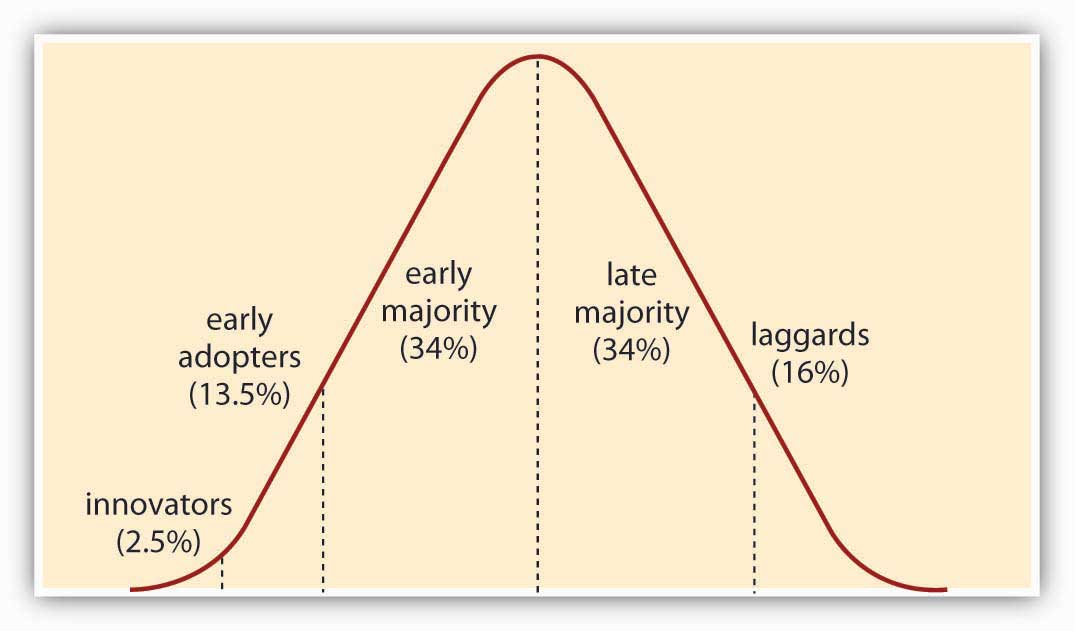This is “Diffusion of Innovations”, section 4.3 from the book Advertising Campaigns: Start to Finish (v. 1.0). For details on it (including licensing), click here.
For more information on the source of this book, or why it is available for free, please see the project's home page. You can browse or download additional books there. To download a .zip file containing this book to use offline, simply click here.
4.3 Diffusion of Innovations
Learning Objective
After studying this section, students should be able to do the following:
- Discuss the diffusion of innovations process and its various stages.
Communications often involves new ideas, new products, and new information. Whether people adopt a new idea or product depends on many factors. The communications model for advertising (discussed above) is affected by the forces that govern the diffusion of innovation.
The Diffusion Model
The Burger “King.” The GEICO gecko. “Bounty, the quicker picker upper.” “Where’s the beef?” The “swoosh.” Most of us are very familiar with these advertising characters and phrases—in fact, some days it seems everyone we know sends us the same hilarious YouTube clip to check out the latest spot. Did you ever wonder why a phrase you hear for the first time one day suddenly comes out of everyone’s lips a week later? How does this process work, and why should we care? The latter question is easy: Advertising depends on the transmission of information among members of a society to spread the word about new ideas, products, and services.
A lot of cutting-edge advertising strategies depend on our willingness—and enthusiasm—to share information and ideas that appeal to us with others. Indeed, this is the backbone of viral marketing, which we’ll talk about in detail later—basically this term refers to a process where people pass on a phrase, a joke, a slogan, or perhaps a URL to their network of friends, who in turn pass it on to others until thousands or even millions of us see it (think about how often more than one friend or acquaintance sends you the same e-mail joke). Each of these little pieces of information is a memeA unit of cultural information that is passed from one person to another, especially by imitation., a unit of cultural information (the biologist Richard Dawkins coined this phrase in his book The Selfish Gene).Richard Dawkins, The Selfish Gene (London: Oxford University Press, 1978).
Today memes travel at ferocious speeds as they bounce around in cyberspace. For example, the Web site http://www.4chan.org is one of the most prolific launchers of new memes. Its progeny include LOL (laugh out loud) cats (humorous images of cats with loud text beneath them in a fake language called “LOLspeak”; this meme also spawned the popular Web site icanhascheezburger.com), the phrase “So I herd u like mudkips” (a reference to a sea creature from the animated show “Pokémon” that generated thousands of tribute videos on YouTube), and the practice of “Rickrolling” (where a friend e-mails you to check out an online video; when you open the link expecting to see something amazing, instead you’re sent to a video of Rick Astley’s 1988 hit “Never Gonna Give You Up”—dude, you’ve been Rickrolled).Jamin Brophy-Warren, “Modest Web Site is Behind a Bevy of Memes,” Wall Street Journal Online, July 9, 2008, http://online.wsj.com/article/SB121564928060441097.html (accessed July 10, 2008); http://icanhascheezburger.com (accessed July 10, 2008).
An innovationAny idea, product, or service that consumers perceive to be new. is any idea (whether a LOL cat or a new religion), product, or service that consumers perceive to be new (whether it actually is or not!). Diffusion of innovationsThe process by which an idea spreads through a population. refers to the process by which an idea spreads through a population. To grasp how this works, think about the way a cold spreads through a dorm or office. One person “imports” the germ, and sure enough, some of those in his immediate vicinity start to hack away. They in turn transmit the cold to others so that before you know it almost everyone in the building is yearning to breathe free. Hence the viral in viral marketing. To check out (and probably share with your friends) a great new viral site, visit http://www.elfyourself.com.
Who Spreads the “Cold”?
An idea spreads in much the same way as a cold or other virus (hopefully with more pleasant results). The process begins with a small group of people, and then if it’s appealing enough it spreads (diffuses) into a larger market. We define the “spreaders” in terms of the relative speed with which they pick up the new idea:
InnovatorsAbout 2.5 percent of the population, who are the first to adopt a new idea or product. (about 2.5 percent of the population) adopt the idea first. These are usually people who are the hard-core members of a taste culture (e.g., “tuners,” enthusiasts of hopped-up cars, or “gamers,” who closely follow the blogs about a new videogame still under wraps at a studio).
Early adoptersAbout 13 percent of the population, often influential people, who build buzz around a new idea or product. (about 13 percent of the population) often are influential people (including those in the media, such as advertising columnists) who build buzz around a new idea, ad campaign, or product.
The early majorityAbout 34 percent of the population, who adopt a new idea or product, but only once it has become known. (about 34 percent of the population) adopt a product once it has become known. They like to be “up” on things, but only after they’ve already started to make their way into the mainstream.
The late majorityAbout 34 percent of the population, who are skeptical of new products and take longer to adopt them than the early majority. (another 34 percent) are skeptical of new products and take even longer to adopt them. Together with the early majority, this is your true “mass market” consumer.
LaggardsAbout 16 percent of the population, who are the last to adopt a new idea or product; they may never adopt it. (about 16 percent of us) are the last to adopt. In fact, they may never try a new variation—“if it ain’t broke, don’t fix it.” Ironically, sometimes they stick with the tried-and-true for so long that it becomes fashionable again (e.g., Hush Puppy shoes, overalls, or farm caps).
Figure 4.6 Diffusion of Innovations

SS+K Spotlight
The memes and trends are constantly morphing, and new influencer groups are constantly emerging, so as your career goes on as an advertising or marketing professional, you will need to stay ahead of these types of changes and understand how to apply them to your or your client’s business.
Figure 4.7

Many companies specialize in monitoring memes and selling their “cultural intelligence” to agencies like SS+K.
Communication professionals stay on top of things individually, but SS+K also does a few extra things to ensure that its staff is ahead of the curve. The agency conducts a Monday meeting for all three offices, where different account teams present the latest work they’ve launched for a client. Noelle Weaver, vice president, also coordinates Friday Fodder, an event where outside professionals come to speak about their business offerings. The msnbc.com team was inspired by a Friday Fodder presentation from the Brand Experience Lab that ultimately resulted in a piece of the msnbc.com campaign (which you’ll learn about later).
SS+K also uses resources like PSFK, Iconoculture, and The Intelligence Group’s Cassandra Report; their latest report is available to the public: http://www.trendcentral.com/WebApps/App/SnapShots/Article.aspx?ArticleId=7276.
Key Takeaway
Information including new ideas, phrases, and brand names diffuses through a culture as memes. These memes tend to get adopted by certain types of people initially, who spread them to others much like a cold gets transmitted among members of a group. Advertisers need to understand who is more or less likely to “catch” a meme.
Exercise
Pick an example of a new style, product, or idea and demonstrate how the diffusion of innovations can spread an idea through society and the marketplace.




